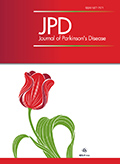Authors: Loeffler, David A. | Aasly, Jan O. | LeWitt, Peter A. | Coffey, Mary P.
Article Type:
Review Article
Abstract:
Mutations in the leucine-rich repeat kinase 2 (LRRK2) gene are the most common known cause of autosomal dominant Parkinson’s disease (PD) and sporadic PD (sPD). The clinical presentation of LRRK2 PD is similar to sPD, and except for genetic testing, no biochemical or imaging markers can differentiate LRRK2 PD from sPD. Discovery of such biomarkers could indicate neuropathological mechanisms that are unique to or increased in LRRK2 PD. This review discusses findings in 17 LRRK2 - related CSF studies found on PubMed. Most of these studies compared analyte concentrations between four diagnostic groups: LRRK2 PD patients, sPD patients, asymptomatic control
…subjects carrying PD-associated LRRK2 mutations (LRRK2 CTL), and healthy control subjects lacking LRRK2 mutations (CTL). Analytes examined in these studies included Aβ1-42, tau, α -synuclein, oxidative stress markers, autophagy-related proteins, pteridines, neurotransmitter metabolites, exosomal LRRK2 protein, RNA species, inflammatory cytokines, mitochondrial DNA (mtDNA), and intermediary metabolites. FINDINGS: Pteridines, α -synuclein, mtDNA, 5-hydroxyindolacetic acid, β-D-glucose, lamp2, interleukin-8, and vascular endothelial growth factor were suggested to differentiate LRRK2 PD from sPD patients; 8-hydroxy-2’-deoxyguanosine (8-OHdG), 8-isoprostane (8-ISO), 2-hydroxybutyrate, mtDNA, lamp2, and neopterin may differentiate between LRRK2 CTL and LRRK2 PD subjects; and soluble oligomeric α -synuclein, 8-OHdG, and 8-ISO might differentiate LRRK2 CTL from CTL subjects. CONCLUSIONS: The low numbers of investigations of each analyte, small sample sizes, and methodological differences limit conclusions that can be drawn from these studies. Further investigations are indicated to determine the validity of the analytes identified in these studies as possible biomarkers for LRRK2 PD patients and/or LRRK2 CTL subjects.
Show more
Keywords: Biomarkers, cerebrospinal fluid, mutation, Parkinson’s disease
DOI: 10.3233/JPD-191630
Citation: Journal of Parkinson's Disease,
vol. 9, no. 3, pp. 467-488, 2019






